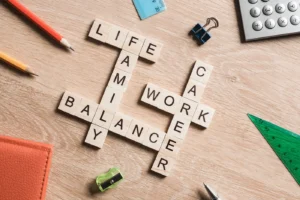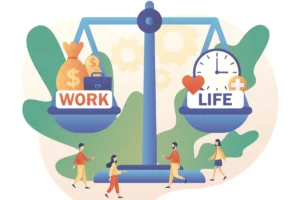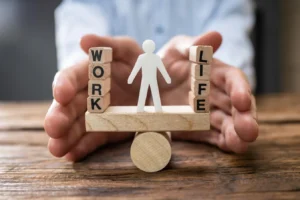Burnout is a regular issue in today’s hectic working environment, resulting in many feeling exhausted, disengaged, and unmotivated to work in their highest capacity. The ever-growing pressures of tight deadlines, increased workloads, and the necessity to remain always productive have exacerbated the problem for professionals from all different industries. This article explains how you can cut down on the stress of burnout and gain control over your personal and professional lives, allowing you to maintain a balanced, long-term approach to your life.
Understanding Burnout
Burnout isn’t just physical exhaustion; it’s a state of mental as well as physical fatigue that is often triggered by stress that is prolonged. In contrast to a long and tiring week, burning out can be an ongoing issue, and it isn’t the only solution. The signs typically include a decrease in enthusiasm for work, decreased productivity, and feelings of insecurity or even apathy towards your responsibilities. The cause is usually rooted in issues like excessive workload, a lack of control over work, inadequate recognition, and a lack of integration between work and life. Knowing the root cause of your stress is an essential first step toward tackling the issue efficiently.
Strategies for Reducing Burnout
To combat burnout, you must make active changes and tangible efforts to stop it from repeating. Begin by setting boundaries to ensure your privacy and time. This includes setting specific limits for your working hours and avoiding the trap of committing too much. Implementing self-care strategies into your daily routine, like regular exercise, a balanced eating plan, and mindfulness practices, will help you restore your physical and mental energy. It’s also crucial to look at the work environment you’re in. Is it a place that is conducive to your health, or is it a source of stress? If you’re in need, have a dialogue with the leadership team regarding reducing the burden of responsibilities and streamlining processes. These small but intentional modifications can make a big impact in helping to regain an aesthetic sense and reduce levels of burnout.
Restoring Work-Life Balance
To restore your balance between work and family, you’ll need to reconsider your priorities and discover the equilibrium between your personal life and work obligations. Start by reexamining the amount of time you devote to various aspects of your life, like relationships, work, leisure, hobbies, and rest. It’s essential to implement methods that help you achieve the balance of your life, like having regular breaks during working hours and disconnecting from your work schedule during the time you are away from it. Be aware that achieving a balance between work and life does not mean dividing time evenly but rather making sure that neither of the areas is always overpowering the other. The pursuit of creativity, meaningful social interactions, and deliberate downtime can boost your motivation and energy, increasing your performance and happiness in both situations.
The Role of Employers
While personal effort is crucial for regaining equilibrium, employers play a crucial part in reducing stress at work and promoting mental well-being. Employers who have flexible working arrangements, such as scheduling options that are flexible or remotely accessible, allow employees to effectively manage their time. Policies that allow for generous parental leave as well as mental health days and paid leave improve the well-being of employees. Employers should also encourage open communication and build an environment of support that allows employees to express their concerns and look for solutions. Leaders must model healthy behavior by demonstrating the importance of integrating work and life by establishing boundaries and encouraging breaks or vacations. If employers are invested in the health of their employees, it helps prevent burnout and boost engagement, loyalty, and productivity.
Long-Term Solutions
Reducing stress and balancing work-life isn’t a quick fix; it’s a continuous process that requires constant attention and attention. Strategies for the long term include reviewing your goals to make sure they are aligned with your goals and personal values. Regular self-reflection and changes to your routines are a great way to keep your equilibrium in check throughout the course of time. Establishing a network of supportive colleagues, friends, and mentors who help you focus on balance can help you to be accountable and motivated. Utilize tools such as productivity apps to manage your work and efficiently manage your work. The ultimate goal is to develop a system of life and work that’s durable, satisfying, and adaptable depending on your personal needs and the circumstances you face. change.
A Healthy Balance for a Happier Life
The pursuit of balance in work-life and reducing burnout demands deliberate changes at the individual and organizational levels. By understanding the root causes of burnout, using efficient strategies, and creating environments that are supportive, employees and workplaces can reduce stress and improve standard of living. No matter if you’re a professional in search of personal improvement or a business making its own policies, a sane approach is beneficial to all those affected. Begin today by making small but significant changes that promote health and well-being. You’ll be able to experience real harmony between working and living.
FAQs
1. What is burnout, and what is the difference from normal fatigue?
Burnout refers to a state that is characterized by prolonged mental, emotional, physical, and mental exhaustion triggered by constant stress. Rest can cure normal tiredness, which is not the same as burnout.
2. What can I do to begin addressing burnout right away?
Make small steps such as making boundaries, taking a break from your work during the day, and incorporating self-care activities such as meditation or exercise into your daily routine.
3. Which role can employers play in balancing work and life?
Employers can help promote a balanced work/life by allowing flexibility, embracing policies, and encouraging an environment of open communication that values the well-being of employees.
4. Is work-life balance the same for all?
The balance between work and life varies between individuals. It’s all about finding the best balance to meet your individual needs and situations while making sure that neither personal nor work is the primary focus for the long term.




